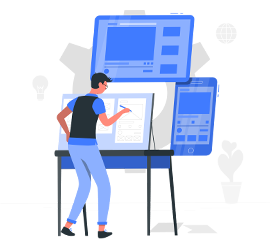January 17, 2021 | How To Create a GPS App: Full Guide To Build Location-Based App Development

Recently companies have come to outsourcing development agencies wondering how to create a location-based app. This interest often comes about due to the popularity of geolocation applications. The market is filled with different types of solutions. While some of these solutions use applications as an additional advantage, which helps to refine the user experience, others use geolocation technologies as the main feature to provide navigation. Touchscreen sensors, 3G, GPS, and Camera functionality are four elephants on which the mobile app world is resting now. So, if you’re up to making a successful location-based service app, you’d better take advantage of these technologies. Regardless of the privacy concerns, geolocation made our lives easier. GPS based apps gave rise to the wide range of mobile apps we’re using in our everyday adventures travelling through cosmopolitan jungles. In this article, we will also explore some new ideas for GPS based applications as well as share our experience on how to create a location-based app.
Let’s dig deeper to know what exactly the location-based services are, the types of location-based services, how to use them, and the industries that are using them to reach new heights.
Best location-based Mobile Apps for Android and iOS
- Uber – Transportation
- TripAdvisor – Travel
- Ola – Transportation
- Google Maps – Navigation itself
WHAT ARE LOCATION-BASED APPS?
Everybody is using location-based apps as an important tool and it becomes a comfort that speed-up the task of finding a person, place, or services nearby. It allows businesses to offer users services near their immediate geographical location. The location details for these apps are transferred through Wi-Fi, cell tower data, and GPS.
When developing location-based mobile apps, you must use location services’ APIs and maps. Location-based mobile apps also offer information about objects close to you, provide respective suggestions about a place or service, useful details, directions.
Adding more location-based features to your iOS/Android app:
Essentially, there are four Google Maps APIs to choose from, depending on the requirements and features you want to have in your mobile app.
- Google Places API – Detailed info about places, the API to power your local business search, enhance navigation, provide directions and information about landmarks. The database contains more than 100 million businesses all over the world.
- Google Maps API – Displays the map itself and allows you to change the color scheme, hide labels, use a different road density, and switch between sites. Besides, you can now create a custom map style, so the map will fit your branding.
- Google Distance Matrix API – It predicts travel time and distance based on a destination set by a user, traffic analysis, and suggested routes.
- Google Maps Directions API – According to the latest survey, more than 57% of U.S. adult smartphone owners use their devices to look up directions. Along with directions, this API allows users to choose transportation mode or take multiple modes.
- Foursquare API- for user recommendations, reviews, and ratings.
- Urban Airship API – You can view the reports in the UA dashboard or integrate the API with your reporting center. You can also export data and statistics from push messages to get insights into your user base.
How to create a location-based app: Full Guide to geolocation app development
Geolocation apps have wide usage in different industries. Geolocation technologies can solve various problems, from outdoor navigation to route tracking, and even help out innovative marketing with relevant ads.
The development process will run smoothly once you hire an experienced team with expertise in the creation of these applications. If you’re thinking about developing a location-based app, then it’s the right place for you we are going to show you the way properly:
- Explore the opportunities within the market.
The first thing you should do is use the geolocation app to come up with new ones or use cases since there is great potential with existing market leaders and potential users. The main thing you need to know is that you can appeal directly to different users, which will set you apart from the competition. You can create your location-based app by talking to potential users and understand the existing market leaders. The one thing you should use to your benefit is how you should appeal to other users, which is what will make the difference for you and your competition. The key here is to find the unique benefit that will appeal to your users and set you apart from the competitors.
- Select the technology for location tracking
The most important thing you should consider is how you should ensure that the geolocation app is reliable and fast. Numerous location-based service apps use the default Google Maps SDK, but if you’re building one for iOS, you can use the native offered by Apple. You can also make use of the native MapKit in iOS, provided by Apple. There are other frameworks you can choose as well if you don’t want to rely on traditional GPS technology, you can consider using WiFi, cellular networks, or Beacons to identify another user’s location.
- App Functionality
You should try using some of the core elements of the app to ensure that your app is completely functional, and integrate it into your location-based app. Some of the core elements of apps with geolocation include the following:
- a map view
- places near me finder
- route mapping
- user location detection
Other features will depend totally on the purpose of your app and its category. It’s important to keep the number of features to a minimum, at least for the first version of the app.
- Data safety
As regulation in the field of data safety becomes more and more strict, you can’t afford to ignore your app’s security, especially when it comes to such data-heavy products as location-based apps. Make sure to comply with the local regulations in every country you want to target with your app.
- Design
Having established detailed wireframes, you can throw your idea to investors to test its functionality/UX with your potential users to create a visual prototype model.
- Development
Engineering is the most important aspect of developing an app that uses geolocation. To ensure that the process is predictive and manageable, we recommend using state-of-the-art development methodologies.
- Testing
Testing is usually considered to be the last step in the software development process. However, we have found the test-driven development (TDD) approach to be much more efficient. In this case, you write the tests even before creating the code, which results in code that contains fewer bugs, and as such, increases transparency and product quality.
How to Build a GPS App Technically?
Location-based applications establish a connection with the satellite with the help of a mobile device’s operating system. The application gets information about the current device location from OS. By collecting and processing data in real-time, it determines the pattern of a moving object or person.
If you’re interested in building a custom location-based application, you should use location and mapping services simultaneously. You can do that in various ways using Cell ID, Wi-Fi, GPS, Geofencing, iBeacon, and Eddystone. We have made the following shortlist to give you an approximate idea of how to create a location-based app that can potentially gain popularity.
-
GPS
Modern smartphones are equipped with a chip that enables users to get access to the Global Positioning System (GPS). Global Positioning Systems (GPS) are global satellite systems, the receivers for which are built into any modern smartphone by default. GPS satellites are scattered on geostationary orbits all around the Earth, thanks to which a device’s location can be determined with a certain degree of accuracy. The position calculation is based on geometric trilateration. The device determines user coordinates on the globe based on distances to different, currently visible, satellites. This type of geolocation tracking is the most widely used today due to the availability of GPS support on devices. Due to the wide popularity and accuracy, GPS becomes the main topic when we discuss how to create a location-based app with our clients. Each satellite broadcasts radio signals with their location, statuses, and precise time information.
-
Cell ID
Cell ID is another technology you need to know about when looking for information on how to create a location-based app. This approach has not become a popular approach due to weak coverage outside of big cities. Cell ID determines location with the help of cell towers. This method of obtaining geographic coordinates is more demanding to environmental conditions and the number of phones in the immediate area because it relies on radio signals of the mobile operator. The technology compares the towers to which a device is connected to the database of all stations in the area. Its accuracy is lower than that of GPS.
-
Wi-Fi
As compared to the Cell ID, Wi-Fi covers smaller areas, which allows the technology to be more precise. There are two ways in which Wi-Fi can be used to determine location. The only problem is finding an open access point, which is not so easy. Fortunately, the inhabitants of metropolises have access to 3G. Nevertheless, one cannot help note the fact that its advantages are leveled as soon as you enter the “blind zone”.
The RSSI approach (received signal strength indication) locates a user with the help of Wi-Fi points. As a device moves away from this point, the signal becomes weaker. If you want to know how to create a location-based app properly, consider this feature. Last but not least, signals of Wi-Fi access points can also be used to pinpoint the device’s location.
If you want to know how to create a location-based app for outdoor use, the above features can create the basis of your future application.
-
Geofencing
This technology is built on GPS, which is used to determine how close a user is to a particular point. Geofencing is often used in the advertising sphere to provide users with relevant ads and offers. However, possible use cases are much broader, and geofencing is a solution that becomes a part of providing a more personalised experience inside a shop.
Amazon Go is the most vivid example of how this technology can be used in real life. The launch of the innovative retail store made many companies wonder how to create a location-based app that could enhance the shopping experience.
-
iBeacon and Eddystone
iBeacon and Eddystone were built by Apple and Google accordingly. These two types of technologies rely on Bluetooth Low Energy (BLE) signals. They can send triggers to a device only when a person is within their reach.
iBeacon and Eddystone are characterized by a high level of accuracy. If you want to know how to create a location-based app for accurate indoor navigation, these two technologies would be a worthy addition to the core functionality.
Want to Create a Geolocation App, but Have no Required Labor Resources?
Location-based apps are all the rage in every industry and have transformed the way brands interact with their customers offline and online. You can create geolocation apps for businesses and always provide your audience with benefits and information in real-time. You can also gain trust and ensure that the private information of your customers is protected. Those are the hallmarks of successful location-based apps.
Do you have a great idea for a business?
If so, get partnered with a development team that has a wealth of experience in building geo-location apps that seamlessly deal with geo-data. You need to contact our specialists who will be able to create a customized mobile application for you in the shortest possible time.
In particular, we at BhadaniTech have been successfully implementing location-based software for years!
Do not hesitate and contact us soon

 .Net
.Net Vue.js
Vue.js Twilio
Twilio Postgre
SQL
Postgre
SQL PHP
PHP React.js
React.js Bootstarp
Bootstarp MySql
MySql Laravel
Laravel Woo
Commerce
Woo
Commerce Firebase
Firebase SQL
Server
SQL
Server Angular
Angular Python
Python ChatBot
ChatBot Wordpress
Wordpress Node.js
Node.js Full
Stack
Full
Stack MongoDB
MongoDB Drupal
Drupal





















